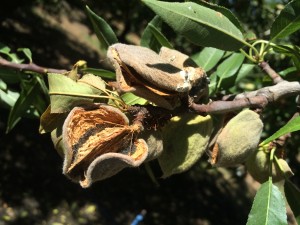Written by Andrew Ray, Staff Research Associate for Univ of CA Cooperative Extension, Merced County

Our water production function (WPF) project within almond has given us an opportunity to look at how irrigation rates can impact the amount of hull rot that develops. The goal of the WPF is to be able to calculate the impact that water applied has on yield. This plot is replicated in three different places across the Central Valley. In the Merced WPF plot, there are five different treatments of water applied at the rates of 110%, 100%, 90%, 80% and 70% of the evapotranspiration rate (ETc). There are 3 blocks of these treatments within an 80 acre orchard. Irrigation rates stayed constant with their established relationship to ET through hull split, and reduced deficit irrigation was not applied.
During mid August hull rot occurrence was estimated in the Merced WPF plot on two trees in each treatment within each block. Twenty five branches were counted on each quarter of the tree, totaling 100 branches per tree, and the number of incidents of hull rot was recorded. There were two ratings performed by two different people and the estimated percentages were averaged. Table 1 shows the averages by treatment of all the trees rated. Included in the table is the average stem water potential (SWP) for each tree and leaf nitrogen percentage. The SWP measurements were taken with a pressure chamber on three separate occasions during hull split in early July. Baseline SWP during that time was -9 bars. Leaf tissue samples were taken in mid July and the average percentage of nitrogen for each treatment.
Table 1: Average hull rot percentage observed in each irrigation treatment, along with average SWP during hull split, and leaf tissue nitrogen percentage.
| %ET | % Hull Rot | SWP
(bars) |
%N |
| 110 | 10.4% | -9.4 | 2.74 |
| 100 | 9.8% | -9.8 | 2.77 |
| 90 | 8.3% | -10.6 | 2.75 |
| 80 | 5.3% | -12.3 | 2.70 |
| 70 | 4.9% | -12.8 | 2.65 |
More hull rot was observed in the more vigorous and less stressed treatments. Leaf nitrogen percentages, although higher than the recommended UC mid-July value of 2.5%, were within a similar range, suggesting that water applied was the only variable to account for the differences in vigor. Previous research has found that increased rates of irrigation increase the amount of hull-rot, and our observations support these findings. It is unknown if the higher amount of hull rot strikes will reduce future yields, but we hope to determine this as we plan to continue this experiment for another 2-3 years.

